|
||
      |
Features ::
The once and future club
Part faculty commons, part neighborhood social institution, the University’s Quadrangle Club has a landmark building, a quirky past, and high hopes.
Accretion is a word Todd Schwebel uses often. It’s something he loathes so much, he’s dedicated his career to its obliteration.
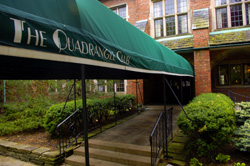 Take
the Quadrangle Club, designed by Howard Van Doren Shaw in the English Arts
and Crafts style in 1922. Since then it’s been subjected to any number
of well-intentioned but low-budget upgrades. When fireplaces and radiators
are boarded over with plywood paneling, that’s accretion. Wallpaper
glued sloppily onto quartersawn oak molding—more accretion. So is
paint on stone windowsills, where it inevitably peels, “because paint
and stone don’t go together,” says Schwebel, X’86, who
along with the Quad Club’s president, architect Michael Rosen, is
overseeing the building’s historic renovation.
Take
the Quadrangle Club, designed by Howard Van Doren Shaw in the English Arts
and Crafts style in 1922. Since then it’s been subjected to any number
of well-intentioned but low-budget upgrades. When fireplaces and radiators
are boarded over with plywood paneling, that’s accretion. Wallpaper
glued sloppily onto quartersawn oak molding—more accretion. So is
paint on stone windowsills, where it inevitably peels, “because paint
and stone don’t go together,” says Schwebel, X’86, who
along with the Quad Club’s president, architect Michael Rosen, is
overseeing the building’s historic renovation.
A nationally known designer who works on the Quad Club project pro bono, Schwebel enjoys scraping some of the accretion away to reveal the building’s great bones. Last year he refurbished a third-floor sleeping room, now called the Howard Van Doren Shaw Suite, in period style, and has the funds to redo two more this spring. The third-floor hallway carpet, once “circa 1968 whorehouse” multicolored shag, has become a demure blue-gray. But most of the 17 sleeping rooms—12 single rooms and five suites—still feature a random mix of gracelessly aging furniture.
The renovation is about comfort as well as style, as Edward A. Snyder, AM’78, PhD’84, now dean of the Graduate School of Business, discovered when he visited campus a few years ago to present an economics paper. His bed had bad springs, so he dragged the mattress onto the carpet, where he slept well until awakened by rainwater “pooling on the floor around me.”
Down on the first floor, in what Schwebel calls “the liberation of the bar,” he and Rosen ordered the destruction of a brick wall, perhaps from the 1950s or ’60s, that carved up and darkened the former billiards room. Several leaded-glass windows that had been boarded shut—for energy conservation in the ’70s, Schwebel guesses—were reopened. Five layers of carpeting, including more sculpted shag, were replaced with a historic cork floor. He is still uneasy about the Prairie-style pendant lights installed a few years ago: “Frank Lloyd Wrong,” says Schwebel, who is also president of the Howard Van Doren Shaw Society, a Chicago organization dedicated to preserving and educating the public about Shaw’s work. “Prairie is not Howard Shaw.”
He is happier with the card room next door. Its track lighting was thrown out, replaced by an antique sconce and chandelier, to match the original fixtures in the lobby. Acoustic tiles gave way to new sand plaster, matching the lobby walls. Not even the curtain rods escaped his notice; they’re now wrought iron. “This room isn’t perfect,” Schwebel says, pointing to an “early motel” coffee table, but the refurbished space meets one of his standards: it looks like it’s always been that way. “The best compliment I get is when people say, ‘Oh, but I thought you did a lot of work here.’”
While the face-lift is the clearest sign of the Quad Club’s renaissance, there are more. After decades of dormancy, the Revels, a yearly tradition of amateur musical productions spoofing campus life, is again a highlight of the Quad Club calendar. A new feature is the Preservation Ball, an April black-tie affair co-sponsored by the Shaw Society. To attract younger members the club has added “First Fridays,” free jazz in the bar on the first Friday of the month. And the steady beat of lunches, served day after day in the second-floor dining room, goes on.
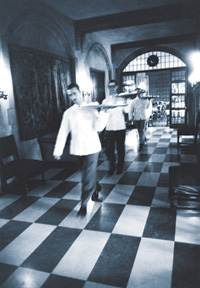
Quad Club waiters prepare for the daily ritual. Credit: University
of Chicago Library, Special Collections Research Center
In 1993, when Emily Kadens was researching a history of the Quad Club to mark its centennial, “there was a real sense that the club had had its heyday and was now in decline,” she says. A master’s student in General Studies in the Humanities, Kadens, AB’92, AM’93, JD’04, learned of the project through one of her professors, Ted Cohen, AB’62, devoted club member and two-time board president.
Interviewing scores of members and reading reams of documents, Kadens eventually submitted the book-length history as her thesis (replacing her planned work on 14th-century cartography) and the Quad Club published it as Creating A Sense of Society: The Quadrangle Club 1893–1993, in hardcover in 1997.
The club’s exact genesis is unclear: 1893 marked its inception, 1894 the first meeting, 1895 incorporation. (The club celebrated its 50-year anniversary in 1945, its centennial in 1993.) Optimistically named the Quadrangle Club—the campus then lacked a complete quadrangle—its governing board included Robert Francis Harper, brother of William Rainey Harper, and Harry Pratt Judson, later the University’s second president. The early club was quite different from today’s: women were ineligible for membership, and food service was not even a consideration. The men who joined, writes Kadens, “were motivated not by the need for a faculty commons but for a faculty community.”
Wildly popular at first, the club claimed more than a third of the University’s 150 faculty as charter members. With dues of $20 a quarter, it was far cheaper than other city clubs—a necessity given that the most senior faculty earned $7,000 a year. The club’s contribution to the young University was invaluable, Thomas Wakefield Goodspeed notes in A History of the University of Chicago, fostering “the extraordinary spirit of unity and fellowship that prevailed between schools, departments, professors, officers of administration, trustees, and alumni.”
Kadens takes a more skeptical view, pointing out that the club’s past is a tale of ongoing financial troubles and an awkward dance with the University—which, contrary to popular belief, does not run the private Quad Club—over funding and control. It’s also a roller-coaster story of waxing and waning interest. In 1912, she notes, outgoing president George Herbert Mead told the annual meeting that the club was a failure; three years later it reached its constitutional size limit and had to establish a waiting list.
The club first met in the Hotel Barry, where International House now stands. Wanting a home of their own, in 1895 members purchased a lot on the corner of 58th Street and Lexington (now University) Avenue. The red-brick structure, designed by Burnham & Company, cost about $21,000 to build and furnish. After construction began the club decided to offer meal service, so a small first-floor dining room was added, along with a basement kitchen. The second floor was devoted to billiards and card rooms, the third to a gymnasium and sleeping rooms.
Two years later membership had expanded to 165, including 80 non-University members, and the building began to seem small. A trio of fires provided an excuse to renovate and expand; the club hired Howard Van Doren Shaw—who later would design the current building—to add an annex nearly as large as the original. The result was “one of the most comfortable clubhouses in the city,” a society paper gushed after the gala reopening in 1898.
Construction and renovation caused considerable financial difficulties, but by 1915 the club was negotiating another move: the University had received a final donation from John D. Rockefeller to build a chapel and needed, for zoning reasons, to control the Quad Club’s lot. The parties hammered out a complex arrangement: in exchange for the club’s land, building, and furniture, the institution agreed to build a new clubhouse at 57th and University, to be leased back to the club for 99 years at $1 a year. The U of C also forgave an existing loan and paid off the club’s remaining debt; the club changed its policies so that University members made up at least 65 percent of active membership; low-ranking faculty paid half dues, and one suite was reserved for the University president free of charge. Construction was delayed by World War I and more financial wrangling, and the new building finally opened with the Christmas Revels in December 1922.
Although the old structure had the misfortune to be standing in the wrong place, it was not torn down. In 1929, when the lot was needed for the Oriental Institute, the clubhouse was rolled across the quadrangle and deposited on the north side of 58th Street just west of Ellis, where it is now known as Ingleside Hall. Changing the orientation of the north-facing building was too difficult, so the building’s backside now faces the street.
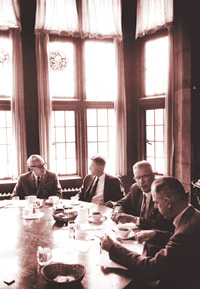
The Round Table became a noontime tradition during World War II. Credit:
University of Chicago Library, Special Collections Research Center
After moving into its new quarters, the Quadrangle Club in the 1920s and ’30s experienced what Kadens calls its “golden age,” the full bloom of its gentleman-scholar traditions. After lunch men relaxed in the solarium, reading newspapers or playing cards; later in the afternoon they gathered for billiards or cowboy pool. During nice weather the clay tennis courts were used constantly; football coach Amos Alonzo Stagg was among the regulars. Beyond these daily rituals, the club calendar was dotted with dances, bridge nights, ladies’ nights, movies, and social evenings—often an ethnic dinner followed by a lecture on the country it represented. Former Chicago alderman Leon Despres, PhB’27, JD’29, the club’s member in longest standing, joined during this era. As an undergraduate he had longed to see the inside of the “Q Club,” as he calls it, “this wonderful space that was forbidden to us.”
Despite ladies’ nights and social evenings, the club remained a masculine haven. During World War I female faculty had been extended “ladies’ privileges,” but they were discouraged from lunching during peak hours and could not use the library or enter the billiard room—rules strictly enforced by members who lived in the club. “I wish I could take off my coat and play billiards with my colleagues while we discuss world politics,” economics professor Mary Gilson wrote to University President Robert Maynard Hutchins in 1937, to no avail.
Club minutes reveal, however, that women did venture beyond the allotted space. In 1939 the council banned women from the third floor—containing only sleeping rooms—after 11 p.m., adding that because of “increasing numbers and intensity of complaints,” it “urgently requests that visits of ladies…be conducted with the utmost regard to the conventions and in good taste so that the good name of the Club be not further endangered.”
During World War II two lunch traditions appeared: departmental tables, where professors could sequester themselves and talk shop, and the Round Table, sometimes called the House Round, which brought together faculty from all disciplines. Speaking at the club’s 50-year anniversary party, classics professor Gordon Laing noted that while eating lunch at the Round Table, one colleague had taught him quantum theory—“he disposed of it as he did of the liver and bacon which was his luncheon choice that day”—and another had clarified some of Einstein’s theories “in a few words while he was buttering a roll.” The Round Table should be considered the highest of all levels of education in the University, Laing suggested, “for it is concerned with the education of the faculty.”
For men who could afford the dues, the Quadrangle Club was not particularly hard to join. During its first 50 years only three aspiring members—none affiliated with the University—were turned down. In 1944 the club rejected its first University member, sparking a debate that led to the downfall of the men-only tradition.
His name was Gordon Dupee, and, coincidentally, he was research director of the University Radio Office with responsibility for the University of Chicago Round Table—a program named after the Quad Club’s most famous piece of furniture. His application was proposed and seconded by two professors of education, but six others, including English professors Norman Maclean, PhD’40, and Ronald Crane, AB’42, AM’47, opposed the nomination. The reasons for Dupee’s rejection remain muddy. A few months before, he had worked briefly as the club’s headwaiter, so there may have been class issues involved, and as a waiter he allegedly had annoyed some members. More significantly, he was a pacifist opposed to World War II. The councilors maintained that they had rejected him, 5-1, because of his “attitude and personality,” not his politics. Hutchins was among many who doubted this explanation. If Dupee had been rejected for his pacifism, Hutchins wrote in a letter of resignation, “I do not see how I can remain a member of the club.” The controversy—like everything involving Chicago’s charismatic president—was widely covered in the media, from the Chicago Tribune to Time magazine.
The Dupee affair caused a rift as members split into two factions, “liberals” and “conservatives.” To bolster their argument that the club was elitist, the liberals tried to establish a pattern of discrimination. For years rumors had circulated that Allison Davis, Chicago’s first tenured African American professor, had been unable to join. In one version the Rosenwald Foundation, which sponsored his professorship and wanted him to fit in without incident, prohibited him from applying; in another he was quietly told his application would not be accepted and so withdrew it.
These rumors could not be substantiated, but the second-class status of women was clear. At a special meeting in June 1945 a group led by Robert Redfield, PhB’20, JD’21, PhD’28, dean of the social sciences, sought to add several amendments to the club’s constitution, including opening full membership to “all members of the University of Chicago, men or women.” More than 300 members attended the meeting, including Leon Despres, who recalls it as “very spirited” with “lots of animosity.”
When the amendments were defeated 182 to 85, Redfield and others resigned. According to Kadens, women were the sticking point: “Most of the club members could accept blacks and pacifists, but even the more liberal members feared that permitting women would mean the demise of their club.” The next day the club again made national news when 17 employees, protesting what they called the club’s racism, walked out as the faculty arrived for lunch.
In December a committee tasked with reviewing the matter concluded that no applicants had ever been rejected because of “race, religion, and social, political, or economic views.” Some members considered the report a whitewash: “A pacifist was blackballed because he was a pacifist, and a Negro was discouraged from applying for membership because he was a Negro,” one complained, and five members resigned.
If the liberals’ heartfelt arguments couldn’t change the club, market forces did. In 1945 a group led by Milton Mayer, X’32, tried to set up an alternative: a faculty club that would be less expensive and open to all. Though the idea came to nothing, the threat spurred the club to open its doors to women and minorities alike. In a spirit of reconciliation, the council waived the initiation fee for members who had resigned over Dupee. Hutchins and Redfield both took up the offer, though Redfield did so without pleasure: “‘Now I have to rejoin the damn Quadrangle Club,’” classics professor James M. Redfield, AM’54, PhD’61, who was about ten at the time, remembers his father saying.
Hutchins reentered the club in a surprise cameo appearance in the 1948 Revels, Little Red School on the Midway, a spoof of communist investigations of Illinois schools. Hutchins—whose appearance stunned most of the cast as well as the audience—received a standing ovation. The 1949 Revels, You’re in the Styx, Professor, featured an even more famous Hutchins appearance. For his role as bouncer at the Elysian Club on the River Styx, he wore an old Chicago football uniform and sang “Rose Bowl Blues.” Hutchins’s appearance got more attention than the plot: the gentlemen’s Elysian Club is rescued from insolvency by admitting women members.
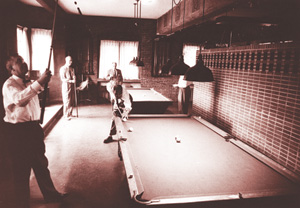
By the 1950s part of the billiards room had become a cocktail lounge.
Credit: University of Chicago Library, Special Collections Research
Center
Despite the success of the Revels and the influx of women members, the club still struggled financially—and the struggle began to starve the remaining vestiges of the gentleman’s-club traditions. Facilities that did not generate income, such as the chess room, were converted into more dining space; the library and solarium were rented out for banquets, much to old-timers’ chagrin. In 1956 the club acquired its first liquor license, and soon afterward four of the six billiards tables made way for a new cocktail lounge.
Even as it slowly changed from gentleman’s club to faculty commons, for some members it continued to inspire almost fanatical devotion. Chemistry professor Stuart Rice, for example, joined in 1957, and, except for sabbaticals and days at Argonne National Laboratory, he has eaten lunch at the club every weekday since: more than 9,000 times. Rice sits at the end of the chemistry table, a long table on the dining room’s north side, not because he is the most senior member, but because “I have long legs.”
Rice’s first independent research, on the theory of diffusion in solids, grew out of a lunchtime discussion: “I said I didn’t believe the theoretical treatment, and I was challenged by some of my colleagues to do better.” While science is a major topic, talk also turns to politics, both national and departmental: “A lot of potential difficulties get worked out,” he says. Eating lunch together “makes us a faculty, as opposed to individuals.” The chemistry department considers this collegiality so important that it pays half the cost of assistant professors’ lunches to encourage them to eat there.
Asked his favorite dish, Rice shrugs: “I just get whatever’s on the menu.”
In 1961 the Quad Club hired a new manager. Nicholas Fulop moved into the first-floor manager’s apartment and stayed nearly four decades. When Fulop arrived the club ran yearly deficits, and the building desperately needed renovation. Fulop decided to balance the books via catering; in one of his first moves, he tripled the seasoning in the club’s famously bland food. (Saul Bellow, X’39, once “resigned ‘on principle,’” James Redfield recalls, “‘because of the cuisine.’”) “Nick turned the club into a very profitable organization,” says historian Kadens, “but he did it by essentially turning it into a restaurant.”
Fulop also led the renovation. He had the sleeping rooms repainted and recarpeted and retiled the bathrooms himself. From Schwebel’s perspective, Fulop was layering on accretion, but at the time it was seen as a great improvement; in 1962 board minutes, secretary Karl Weintraub, AB’49, AM’52, PhD’57, praised the “better bath and shower facilities, including plastic tiling.” At year’s end, despite substantial renovation costs, the club already showed an $8,000 profit. The next year Fulop had air conditioning installed (adding ductwork Schwebel would like to rip out). There was talk of a swimming pool, inspiring third-floor resident James Brown IV, AM’37, PhD’39, to opine that “faculty children are notoriously ill-behaved, especially when dripping wet.”
But Brown and the other permanent residents were soon on the way out, because renting rooms by the night was much more profitable. The library, which generated no income, dwindled to practically nothing. The club had been transformed, abandoning what Kadens calls “the profitless niceties of the home-away-from-home of the prewar gentleman-scholar.”
The Quad Club may have sported funky new shag carpeting, but it remained a bastion of institutional tradition and power, and so became a natural target for student protesters in the late 1960s.
The protests began peacefully in May 1966, when six students staged a weeklong sit-in and hunger strike. The six belonged to Students Against the Rank, a group protesting Chicago’s policy of releasing male students’ class ranking to the Selective Service. Another 140 students fasted in the main quadrangle to show support. “We’re just sitting here watching the decision-making process going on,” one Quad Club protester, philosophy grad student Joe Lubenow, AM’65, told the Chicago Maroon. The venue was chosen, he said, because “this is where the faculty members eat.”
Some members took the sit-in in stride, such as Hannah Arendt, professor in the Committee on Social Thought, who held discussions with the protesters about fasting around the world. Others, like physicist William Zachariasen, were deeply upset. While many faculty and administrators refused to comment, Zachariasen told the Maroon he’d vowed not to enter the club until the students left: “I don’t question the right of students to show disagreement with the draft, but for godsake not at the club.”
Manager Fulop was furious. He wanted to call the police, evict the students, or close the club, but the board—taking advice from Provost Edward H. Levi, PhB’32, JD’35—would not allow it. When Fulop heard rumors that the strikers were secretly eating pizza passed in through the bar windows, he took a small stand: he installed locks.
In 1969 student unrest grew angrier and more aggressive. From January 30 to February 14 about 400 students occupied the Administration Building, protesting the dismissal of a popular young professor. On February 4, 30 members of the “Chickenshit Guerrilla Brigade” barricaded a group of administrators inside the Quad Club. According to the Maroon, the “Chickenshits” marched around the building tooting kazoos, singing, tapping on windows, and chanting “61,” the number of students that the University’s disciplinary committee had already suspended for the sit-in.
When the barricaded administrators—including then-President Edward Levi—emerged, they had to push their way through the chanting crowd. Julian Levi, PhB’29, JD’31, professor of urban studies and executive director of the Southeast Chicago Commission, pointed his pipe at several students and shouted, “You’re 62, you’re 63, you’re 64…” When a student suggested they just wanted to talk, he shot back, “Look, do me a favor, forget two words— ‘relevant’ and ‘dialog.’”
But the attempt at dialog continued on February 24, when about 100 students gathered at the president’s house with a petition demanding that the disciplinary committee accept a collective defense. They pounded on doors and windows until a female student managed to kick in a window. When campus police dispersed the crowd, a core group of 70 marched to the Quad Club and into the dining room. According to a historical account by Dean of the College John W. Boyer, AM’69, PhD’75, “they taunted guests who were eating, took food and wine from the tables, cursed various faculty members in the room, and held mock meetings.” As the Maroon reported a few days after the event, the demonstrators actually munched crackers, as the buffet food was “snatched away to the kitchen.” Half an hour later the protesters held a vote and decided to leave—after taking up a collection for the waitstaff. Dean of Students Charles O’Connell, AM’47, later told the Maroon the protest was “the most mindless, the most senseless, and the most child-like behavior” he had ever seen on campus.
The winter’s final protest came February 28, as suspended undergrad “Rabbi” Jeff Mason led a block-long procession to the club. Blowing a shofar, Mason marched the demonstrators around the building seven times, chanting “amnesty now” and “walls fall down.” The group retreated across the street to watch the building collapse, but, the Maroon noted, “It did not.”
A few months later a group of 60 professors demonstrated outside their own club. Hoping to pressure the administration to reduce the punishments meted out to students, the group stood in silent vigil at noon. Like the student protests that preceded it, the May 6 demonstration accomplished little.

Chefs at work, perhaps without benefit of spices. Credit: University
of Chicago Library, Special Collections Research Center
The 1980s and 1990s were, by most accounts, the Quad Club’s quietest period, when it was a place for faculty to eat lunch and not much else. Member Ruth O’Brien, AB’83, AM’91, who waited tables there as an undergrad, recalls the “hideous uniform—orange and brown,” the paper placemats that faculty sometimes doodled on, and the orange naugahyde booths in the bar. Along with their pay, waitstaff got a free meal. The best dish, she says, was a hamburger and fries. Nonetheless, O’Brien says, she “fell in love” with the club and was delighted to join years later.
Kadens’s history skims over 1966 to 1993 in a final, four-page chapter. What she could not have anticipated, Ted Cohen says, was that when Fulop retired in 1999 the club would acquire “a new kind of board that reenergized itself” and young members with ambitious ideas. The club had been “coasting,” says Cohen, “but an object can coast for a long time, as Newton tells us. If nothing stops it, it will go forever.”
Cohen’s wife, courtroom artist Andy Austin, is the invisible hand behind many changes at the Quad Club, though she downplays her contributions: “I’m not even a member. I’m on Ted’s membership.” It was Austin who organized an event to restock the library, asking members to donate books they’d written. It was she who formed “The Friends of the Quad Club,” which suggested First Fridays and the Preservation Ball. And it was Austin who encouraged Schwebel to cochair the ball—along with O’Brien, now a University development officer—and helped get the nonprofit Shaw Society involved.
Money raised at the first ball, held in 2001, repaired the slate roof, and later galas paid for the interior refurbishments. But the pace is slow—at the current rate, club manager Christ Nogulich estimates, the renovations could take 15 or 20 years—and the club’s lease expires in 2016.
Two years ago the club asked the University for help, and the administration responded by hiring the Washington, D.C., consulting firm Brailsford & Dunlavey to do a study. Besides surveying club members and non-members in the University community, the consultants looked at faculty clubs at Harvard, Princeton, Yale (which has since closed), Columbia, Johns Hopkins, and Stanford. Unlike the Quad Club, all receive significant financial support from their universities.
The report, completed in February, is confidential, but its complaints are hardly novel, Cohen says: high dues, outdated menu, decrepit sleeping rooms, general stuffiness. “Anyone who complains about the dues and fees, then also demands big changes, just doesn’t understand the club’s finances,” says Cohen. Although an August 13, 2003 Chronicle of Higher Education article named the Quad Club one of the nation’s top faculty clubs, “the faculty notoriously like to complain about the place,” says historian Kadens. As Nogulich puts it, “I get a survey every day.” The University hasn’t yet acted on the report. “We believe that we need the Quadrangle Club,” says Provost Richard Saller, “but no decision has been taken. It may take some time to work out an agreement.”
Despite the criticism, dues are low compared to those of other city clubs, which partly explains the club’s difficult financial situation. University members pay on a sliding scale, from $285 a year for those who earn under $25,000, up to $465 for those making $100,000 or more. Junior and incoming faculty get a special deal their first year: their dues apply to food and beverage expenses.
For so-called “non-University” members, dues are $465, while members in other categories (permanent non-resident, emeritus, widows/widowers, and visiting) pay lesser amounts. Alumni can join at the non-University rate, and are very much wanted, says Nogulich: “We would love to have several hundred more members.” Applicants need only find two members to sign a one-sentence statement: “I believe that he/she is in every respect worthy of admission.” Though members have the right to try to keep hopefuls out, in practice, Cohen says, “I think 15 years ago there was someone who almost didn’t get in.” Only students, even graduate students, remain personae non gratae.
Shaw designed the building for a membership of 400, but the club is not overcrowded now, even though membership tops 1,100. (The number is approximate, because the membership list has also been neglected. When invitations to the first Preservation Ball went out, Austin says, hundreds came back because the addressees were dead.) Non-University members tend to eat dinner at the club (served Monday through Saturday from 6 p.m. to 8 p.m.) rather than lunch (Monday through Friday, 11:45 a.m. to 2 p.m.), traditionally dominated by hungry professors. Still, “a lot of faculty don’t use the Quadrangle Club,” says chemist Rice, “and I think it’s to our detriment. The club is an important part of the collegiality of University life, that there’s too little of.”
The University is “an exceptionally iconoclastic place,” says Cohen. “Its characters are not joiners.” Kadens, who has taught at the University of Chicago Law School and next year joins the University of Texas School of Law, is perhaps typical. Despite the thousands of hours she spent in the club researching her book, she says the thought of joining never even occurred to her.
Cohen’s own devotion to the Quad Club—he eats lunch there nearly every day, and plays pool for an hour afterward—harks back to an earlier era, or, he hopes, heralds a new one. In the last few years, he’s detected “something of a sea change” in attitudes at the University: a desire for more belonging. O’Brien falls into this group. Lunchtime at the club, she says, reminds her of the fun of eating at the cafeteria as an undergraduate: the stimulating conversations, the guaranteed company. “In some ways the University is a huge place, but this is an intimate setting for the exchange of ideas,” she says, “And frankly, the fact that it’s beautiful helps.”
Hey, profs, let’s put on a show!
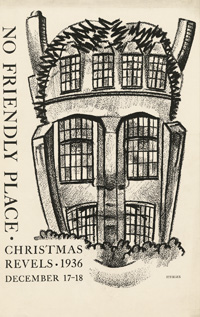 1904
Quadrangle Club holds its first Christmas Revels. Scenery is simple and
the actors barely rehearsed, but the black-tie audience also gets a dinner
and dance.
1904
Quadrangle Club holds its first Christmas Revels. Scenery is simple and
the actors barely rehearsed, but the black-tie audience also gets a dinner
and dance.
1928 A flu epidemic fells the Revels—as had World War I.
1936 The Faculty Wives Dinner debuts. Held the night of the Trustees’ Dinner, the event occupies wives while their professor husbands dine with the board.
1937 The stage show gives way to a movie by Durbin Rowland, X’23, a professor and club resident. A Nightmare of the Vice-President features President Hutchins’s first Revels appearance, as himself. Rowland donates the reel to the club with the request for a 10th-anniversary encore, but it gets quietly panned and canned.
1939 Back to basics, with a new twist: the wives’ chorus line.
1950 The now-SRO Revels move from the Quad Club to the 1,000-seat Mandel Hall. For the rest of the 1950s productions are professional and ambitious, even as plots stay focused on campus and club concerns. The pool of writers includes English professor Edward H. Rosenheim, AB’39, AM’46, PhD’53, and GSB professor Robert Ashenhurst.
1958 The Sky’s No Limit is directed by Studs Terkel, PhB’32, JD’34. Ashenhurst cowrites six songs, including “57th Street Creep,” about the scruffy proto-hippies on 57th Street, and the show-stopping “Rah,” sung by a coed who secretly despairs of the “huge grey cloud/the Camus-Kafka-Kierkegaard crowd.”
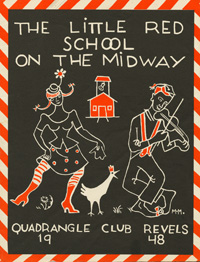
The Club’s annual Faculty Revels grew more professional near the
turn of the century. Credit: University of Chicago Library, Special
Collections Research Center
1968 When no writer, director, or producer steps forward, the show is canceled.
1980 The Faculty Wives Dinner, which ran through the ’70s, taking on sex and psychoanalysis, housing shortages, urban renewal, student unrest, and women’s liberation, dies when the Trustees’ Dinner is canceled. But the Revels make a comeback. Veterans including Rosenheim and Ashenhurst put together a show for the Quad Club stage. University President Hanna H. Gray is, as per tradition, asked to participate; one year she phones in, via an answering-machine recording,
2001 Revival redux: Rosenheim and Ashenhurst are enticed from retirement and collaborate on several shows, including the 2004 centennial number. Rosenheim explains a certain sameness in the story lines: “If you take a basic Aristotelian notion of comedy—suffering on the part of a victim who deserves it—your natural targets are likely to be academic stereotypes, self-righteous, stuffy, so you can vulgarize them—painlessly, again, as Aristotle says.”
2005 Mob Musical. All bets are off when West Side mobster Don Rocco Sparafucile Fagiol wants to build a casino on the Midway. Cameos are provided by a trumpet-tooting President Randel, as himself; state representative Barbara Flynn Currie, AB’68, AM’73, as a nightclub floozy; and mystery writer Sara Paretsky, AM’69, MBA’77, PhD’77, as an operatic Detective Warshawski.